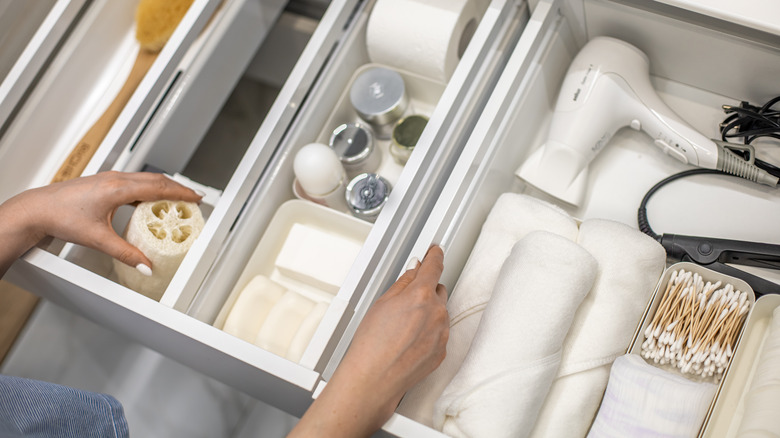Here Are The Cleaning Hacks Marie Kondo Swears By

If you have an ear even slightly to the ground where it comes to either pop culture or cleaning and organizing hacks, you’ve almost certainly heard the phrase, “Does it spark joy?” This quote refers to one of Marie Kondo’s cardinal rules of keeping house, which deviates a bit from the old fashioned “each time you buy a new thing, get rid of one old thing,” which was meant to help prevent clutter. But what’s different about Kondo’s approach is her allowance for human emotion.
According to Marie Kondo’s official website, “your feelings are the standard for decision making – specifically, knowing what sparks joy.” In order to figure out whether items in your home “spark joy,” Kondo’s method suggests that while cleaning up your house, each time you come in contact with an object, pick it up, and ask yourself, “Does this spark joy?” And then the key is to pay attention to your body’s response. “Joy is personal, so everyone will experience it differently,” her website says. Kondo describes this feeling of joy being sparked as “…a little thrill, as if the cells in your body are slowly rising.”
This allowance for the type of attachment we make to the objects, clothing items, etc. that we collect feels more authentic and more do-able to many than the harsh “one thing in, one thing out” rule. Kondo also has a few other helpful tips to help make cleaning less daunting.
Imagine what you want to do in your home
Society 19 has listed some of Kondo’s most useful cleaning and organizing tips, and they all take into account our humanness better than some of the hard-and-fast cleaning rules that have been imposed on us all our lives, like “pick up as you go,” and “if you take it out, put it right back,” because if we are honest, these don’t always work so well for every person or every family in every situation. When we don’t keep things perfectly tidy, we can feel like we are failing and give up altogether. Instead, give yourself some grace, and consider trying some of Kondo’s tips.
The first is rather than looking at individual tasks as things you simply have to do, consider instead what you want to do inside your home, and picture it. Do you want to entertain guests for a gathering? Then visualize what you would want your space to look like to achieve that. See the gathering and see yourself reveling in your hosting duties. Suddenly, cleaning up the living room doesn’t seem like an abstract chore, but a step toward a joyful goal.
Focus on one category at a time
Kondo also suggests cleaning by category, not location (via Society 19). In other words, rather than deciding you need to clean your bedroom, focus on a particular category throughout the house first. The categories she lists are clothing, books, papers, miscellaneous items (dishes and kitchen items, bathroom items, etc.), and finally sentimental items. This helps because if we focus just on the bedroom, there might be laundry, books, dishes, and sentimental items all over. We can get stuck in the emotions of the sentimental objects, or we will get caught up doing the laundry we found in the bedroom, but then feel overwhelmed when we also need to do the laundry in the bathroom, the kids’ rooms, etc. when we had wanted to finish the bedroom. If we focus on the laundry, then on the books, then the dishes, then the sentimental items, suddenly the bedroom is clean, and many other places are, too.
Kondo also points out that if you notice yourself becoming emotional when tidying or considering getting rid of sentimental items, it’s okay. This is normal. Don’t punish yourself for “slower productivity” when you get to these items. Allow yourself to feel what you feel as you hold these items in your hands. Not only will this allow your emotions to move through you, but it can actually help you decide where such items belong, and whether they still “spark joy.”
Source: Read Full Article


